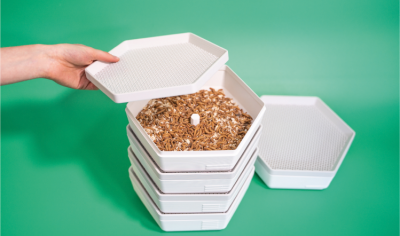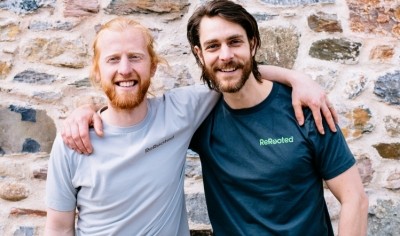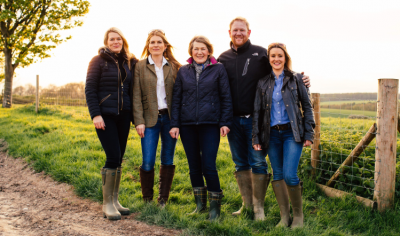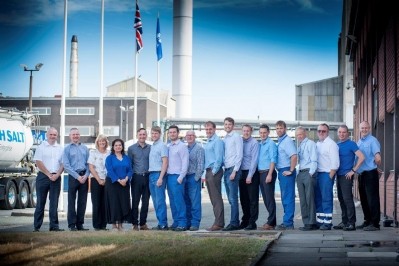Me and my team
Protein potential at Essentia
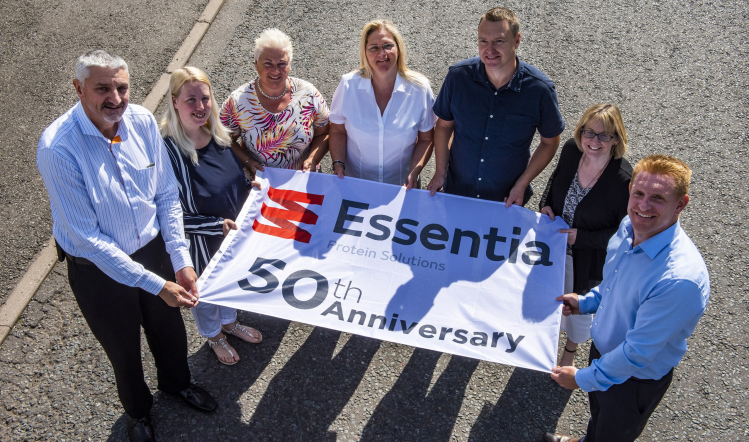
Essentia is a global business specialising in the production of animal proteins for food manufacturers. Here at Tipton, we process pork and beef rind- derived protein, which is used in prepared meat products.
Employing 54 staff, it is the only specialist protein factory with the group located in the UK. We celebrated our 50TH anniversary in 2019.
Products manufactured here fall under our Drinde and ScanPro brands. Our Drinde range incorporates all the pork rind-derived protein we produce here, and is used in sausages, savoury bakery products and hams. ScanPro is the beef equivalent.
Further afield, the company also makes the ProBase range of savoury stocks and broths, blood proteins under the Apro brand, and the Hydro and Omni health and nutrition applications.
Manufacturing rind is a relatively straightforward process. Essentially, we’re taking animal skin, cooking it, dehydrating it, and then milling it into something that can be used back in manufacturing. A traditional butcher would typically take all the leftover parts of the animal and turn them into sausages.
The problem, however, is that the fat and moisture content of rind makes for a terrible sausage. Our process takes 75% of the content out, leaving our customers with a high-protein, clean-label and stable product that can be classified as meat on ingredient lists. It also has a shelf-life of two years.
Tracing origins
Production is in batches, which, with the help of the Foodware enterprise resource planning system, allows us to fully trace the origin of each batch. When I started here 15 years ago, we mainly just sold Drinde in different particle sizes. Today, to meet ever- growing traceability demands, we have to segregate the rind by its origin, or whether it’s British Quality Assured Pork, or Red Tractor-accredited.
The process begins by mincing the rind into more uniform pieces, which allows them to cook more evenly in the fryer. The pieces are fried at a high temperature for a very short period of time, before being cooked properly. By this stage, the rind looks more like pork scratchings. However, before it is ready for milling, it is blasted with cold air – if you tried to mill the material when it was hot, it would just smear.
We use a hammer mill to produce coarser particles, which are popular in products such as faggots. A second mill allows us to get the rind down to 350ΜM, at which point it becomes injectable. This gives the customer more flexibility with the final application.
We also sell a quantity of oversized particles, which act a bit like popcorn when they are heated. They are proving popular on tops of joints, and we’re finding there’s a market for them.
While we operate in a fairly mature market, we have managed to increase our turnover by 20% over the past decade. This has been helped by expanding our site footprint with the purchase of several surrounding business units.
It means we are now able to keep all finished product on-site, while also giving us the potential for future projects.
Continuous improvement
In recent years we have spent almost £3m on improving and updating both plant and facilities. We also feel it’s vitally important to invest in our workforce and are proud to have introduced the Living Wage in 2019.
There is a flat hierarchy at the site, and I have an open-door policy. Regular team briefings cover all departments, so staff get an understanding of the whole business. Rather than just asking someone to stand on a line and sort some rind, we want them to understand how what they are doing impacts the overall company.
More than a third of employees have been at Essentia for at least 15 years, so we believe we’re doing something right. My own career history is a little unusual, in that I graduated from the University of Reading with a BSc in food technology and started in process development, before gradually moving into sales.
While sales remains my main responsibility, I still keep my hand in on the technical side, because it’s important not just to talk about money with customers. It’s great to also be able to say, ‘let’s go into the factory and test it out’.
Understanding the supply chain
Understanding issues throughout the supply chain is important – because they ultimately become our problems. The main challenge lately has been African swine fever (ASF), and the subsequent increase in demand for European pork.
Our prices have more than doubled in less than a year, largely due to the influence of ASF. We’ve managed to absorb some of those costs, but not all. We continue to work very hard to preserve our supply chain and offer customers uninterrupted supply.
There are opportunities, too. Exports make up around 15% of our sales and we work with our global regions to grow this further. With more focus on health, the nutrition sector of our business continues to grow as our products lend themselves perfectly to these applications.
Because we’re using parts of animals that otherwise might be thrown away, we fit in with the current sustainability agenda as well.
Essentia Protein Solutions
Location: Ramsay Rd, Tipton, West Midlands, DY4 9DU
Turnover: £14m
Staff: 54
Factory size: 3,200m2
Products: Drinde (pork rind); ScanPro (beef rind).
Customers: More than 100 food manufacturers.
Number of lines: 3 (2 pork, 1 beef).
Annual output: 5,000t (including bought-in sister site goods).
Tom Cooke: “Football is a major pastime – watching, playing, and coaching my son’s team. I also like to dj in my spare time, and am keen on one day owning a classic car.”

